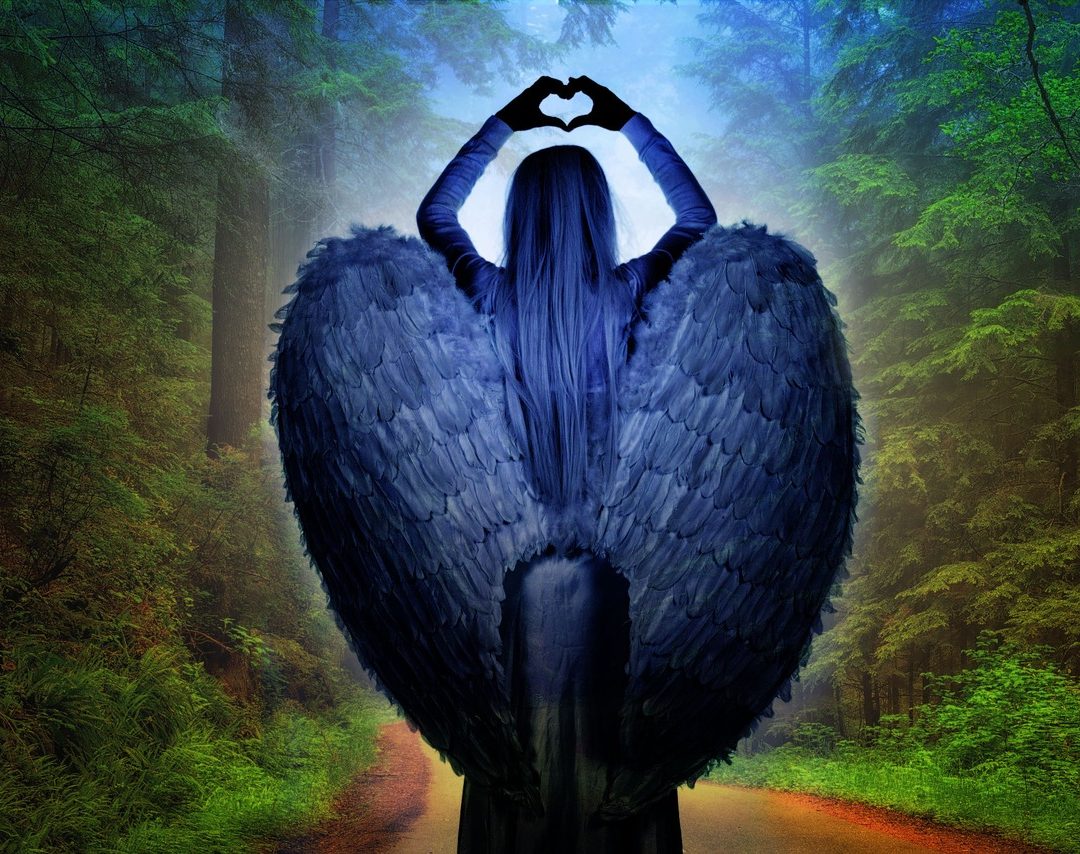
by Somya Devi | Oct 4, 2018 | Astrology, Conjunctions, Planets Changing Signs, Retrograde
I love this time of year. Having passed the equinox on September 22nd, the dark of night comes noticeably earlier. The air temperature, moisture and barometric pressure have taken a definite turn. And the instinct to nest and cozy up at home is on.
From now through the spring equinox, we in the northern hemisphere are in the yin portion of the year, where nighttime exceeds day, and our energy is more naturally directed inward. With fewer hours to be out in the world acting, there is more time to spend still and being. This is a time for the mystic feminine to thrive.
Monday, October 8th will bring a dark Moon night to start the first lunar cycle fully in the yin season. At 8:47 pm PDT, the Sun and Moon align at 21° sidereal Virgo, in Hasta nakshatra. This is a great way to start a season of grounding into ourselves, nurturing our feminine essence and our creative potential. Fittingly, this cycle brings with it the Navaratri festival, the nine nights of celebrating the goddess in her many forms.

Virgo Cycle
Virgo is the feminine earth sign ruled by Mercury. In Sanskrit, Virgo is Kanya, literally the “girl” or the “maiden.” This sign relates to fertility, as well as a pure feminine being. Virgo’s nature compels us to try to take care of everyone and all the details, and as the Sun moves into Libra, his sign of debilitation, later this month, we must be careful not to overexert ourselves and become depleted.
With exalted Mars and Ketu still transiting the fifth from Virgo, this month will call us to explore our creative potential, and what fears and resistance we may hold around that. With Saturn transiting the fourth and Mercury, Jupiter and Venus in the second, there is a lot of energy going towards the home and family this month.
Hasta
Within Virgo, the Sun and Moon align in Hasta nakshatra to begin this lunar cycle. Hasta is “the hand,” and implies all things crafty. We find potential to take up any number of manual skills or projects this month, as well as utilizing the intellect (Mercury) to craft our situations towards our goals. Ruled by the Moon, this star brings forth our feminine nature and guides us from the heart, so be sure to listen in the stillness of the dark Moon nights.
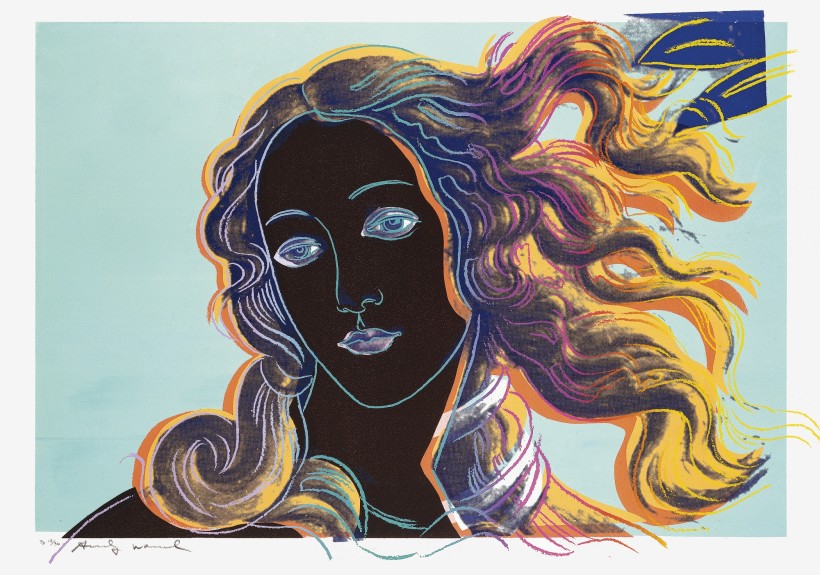
I just love this Warhol image for Retrograde Venus!
Venus
Venus has come to a stop and is entering retrograde motion on October 5th. For all of us, this will be an opportunity to slow down and retrace the steps we have taken towards happiness, as well as look closely at our relationships and our styles of relating. It may feel like a slow-down our happiness or relationships are challenged right now, but every challenge is an opportunity for our own self-development. It’s a good time to work on developing new skills in relating, whether by a communication class, couples’ workshop, or any personal development coaching work.
You may also experience things slowing down in the areas of your life ruled by Venus in your natal chart, different for each Vedic rising sign.
Jupiter
For a few more days, Jupiter and Venus are joined in sidereal Libra, but Jupiter will complete his transit here and move into sidereal Scorpio on October 11th. This next Jupiter transit will last through November 4, 2019. Jupiter in Scorpio can expand our opportunity to connect with the mystic. The depth of self-inquiry and self-development practices will grow during this period. Passions can be heightened and intensified, and our philosophical warrior will be strong.
 Navaratri
Navaratri
The nine nights of the goddess is a festival celebrated by Hindus worldwide. Navaratri will begin on the first night of the waxing Moon this lunar cycle, starting October 9th. On each of nine consecutive nights (nav + ratri), we can worship the goddess, Devi, through her many forms. Most notably this festival celebrates the goddess Durga in nine of her forms, but in other parts of India the festival commemorates Durga/Kali, Lakshmi, and Sarasvati for three nights each.
Devi is the creatrix, the warrioress, the nurturer, the purifyer, the protector. She can be found in the innocent and fertile maiden as well as the wise and learned crone. She is both the nurturing mother, and the one who gives “tough love.” The impassioned lover, the devoted bhakta, the disciplined yogini. We see Devi appear through us in innumerable manifestations. Through her many forms, she teaches us and offers us countless blessings–love, compassion, courage, learning, discipline, surrender, success, enlightenment, and bliss.
This festival is a time for honoring and celebrating the supreme feminine power in all her glory, and the many blessings she bestows upon us. Stay tuned for daily updates on how to connect with the many forms of the Goddess.

by Somya Devi | Sep 20, 2017 | Astrology, Events, Holy Days
Maha Navaratri 2017 begins today! In this important Hindu holiday, we celebrate the Goddess through “the great nine nights” (nav = nine, ratri = night). This festival will run through September 30th, the first ten days of this new lunar cycle. Goddess, Devi, Shakti, Durga, Divine Mother—the many names and forms all represent the dynamic and fluid feminine power that enlivens all of existence.
She is the creatrix, the warrioress, the nurturer, the purifyer, the protector. While she’s in the innocent and fertile maiden so is she the wise and learned crone. Both the nurturing mother, and the one who gives “tough love.” The impassioned lover, the devoted bhakta, the disciplined yogini. We see Goddess appear through us in innumerable manifestations. Through her many forms she teaches us and offers us countless blessings–love, compassion, courage, learning, discipline, surrender, success, enlightenment, and bliss. This festival is a time for celebrating the supreme feminine power in all her glory, and the many blessings she bestows upon us.
As with most Hindu celebrations, this festival correlates with the lunar calendar, and thus begins on the first day of the waxing Moon after the New Moon of September 19th. The celebration is through the “nine nights” of 21st through 29th, and into the eleventh morning known as Vijayadashami, “the day of victory,” on September 30th in some places (because of the way the lunar phases correlate with the solar days… Check the Vedic panchanga for your city to see the exact dates for Navaratri where you are.). Worship during Navaratri is most generally dedicated to Goddess in the form of Durga, the demon-slayer, but there is much nuance and variation to practice and forms of celebration throughout India. Above all, Navaratri is a community celebration of the Divine Mother, and the love, abundance and protection she gives.
There are many Navaratri celebrations throughout the year, but the fall-time Navaratri is the most widely celebrated, and is thus called Maha Navaratri – “the great nine nights”. It correlates with the time of the harvest, a time to give thanks for the abundance of the year’s work. Grains and crops are often offered to Devi as part of the celebrations. Ritualistic worship (puja) typically occurs in homes and temples throughout the nine nights and into the tenth morning of celebration.
The Many Forms of Goddess
Durga-Lakshmi-Sarasvati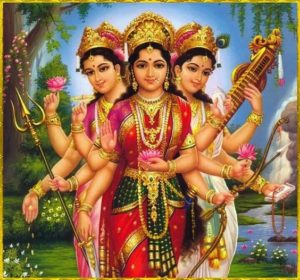
In Kerala and other places in India, the first three nights of worship are dedicated to Durga (the invincible), the next three to Lakshmi (Goddess of prosperity), and the final three to Sarasvati (Goddess of learning). Durga, also celebrated as her incarnation of Kali, helps us to destroy and remove the negative tendencies in our minds and hearts, freeing us from the obstructions to our spiritual and material pursuits. Lakshmi helps us to cultivate positive qualities like compassion and devotion, and leads us towards both spiritual and material prosperity. Sarasvati assists us in attaining knowledge and wisdom, through the illumination of our consciousness. She aids in awakening sattva, the quality of purity, and the flow of prana, the vital breath. After removing inner and outer obstacles and cultivating prosperity through virtuous qualities, our devotion, service, and practice help us to attain a state of peace, bliss, and oneness.
Sarasvati-Lakshmi-Kali/Durga
In the Kali Kula (Kali school of worship) in northeastern India, Sarasvati is worshiped on the first three nights, followed by Lakshmi on the next and then Kali/Durga on the last three. Sarasvati, Lakshmi, and Kali/Durga (Kali emerged from Durga) are also known as the consorts of Brahma, Vishnu, and Shiva. The Goddesses, therefore, provide the shakti to the cosmic processes of creation, preservation, and death (transformation), similar to their male counterparts. Consequently, worship in this manner is dedicated to the cycles of life and Mother nature, through birth, then sustenance, then death. Death is not a complete stop, but allows for the regeneration of energy into a new cycle once again.
9 Forms of Durga
Throughout India, the nine nights of Navaratri are often dedicated to 9 different incarnations of Durga, allowing the worship of many different aspects of Shakti in a gradual evolution. You can read the stories and significance of these 9 goddesses here (or click on Goddess name below), or a more a brief introduction, here:
“Daughter of the mountain”; creative energy, muladhara (root chakra), awakening; Awaken your connection with Goddess today or initiate a new venture, calling on Shailputri for new beginnings.
The ascetic; tapas, discipline, devotion, strength, wisdom, creative abundance; Good day for fasting and meditation, connection with svadhistana (sacral chakra).
Warrioress; protection, courage, grace, manipura (solar plexus); Destroy your internal obstacles by offering them to Chandraghanta.
4. Kushmanda (September 23rd)
Creatrix of the “cosmic egg”; strength, health, happiness, success, relationships; Connect with the vital Sun energy and the anahata (heart chakra) today.
“Mother of Skanda/Kartikeya”; motherly love, nourishment, protection, purity; Call on divine truth through the vishuddha (throat chakra), invoking Skandamata to lead you towards victory.
6. Katyayani (September 25th)
Warrioress who destroyed Mahishasura (the buffalo demon); victory, devotion, strength, removing obstacles; Meditate on these qualities of Goddess through the ajna chakra (third-eye) today.
7. Kalaratri (September 26th)
“Dark/black night,” representing a fierce form of Durga/Kali; darkness, death, surrender, dissolution of pain; Connecting with the sahasrara (crown chakra), remember that Divine Mother offers love, compassion, and many blessings even in hard times. Even in the midst of apparent darkness, and helps us to go beyond the boundaries of the material body-mind and connect with spirit.
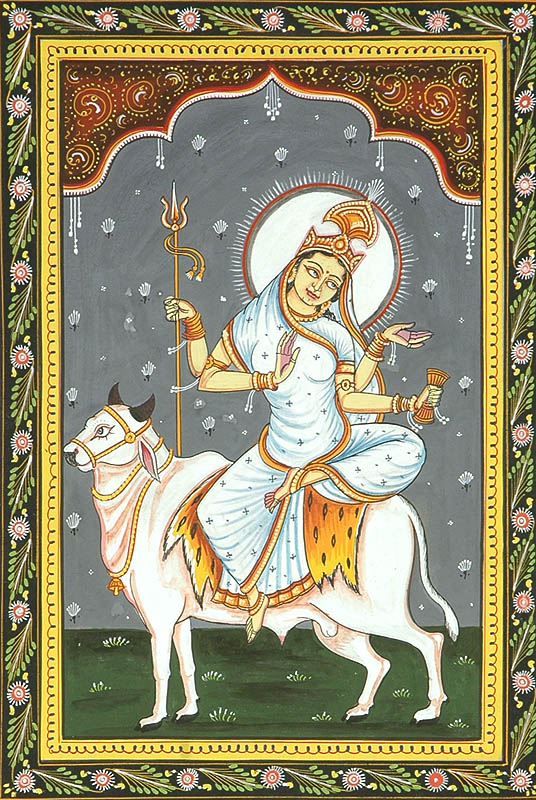 8. Mahagauri (September 27th-28th)
8. Mahagauri (September 27th-28th)
“Great white goddess”; detachment, purification, renewal, protection, virtue; Through detachment and devotion, we emerge purified, shining and radiant after surrendering in the dark night. Rejuvenative herbs and foods are good today.
Goddess of “siddhis”; magical, spiritual or mystic powers and blessings, fulfillment of desires, devotion, divine union; Invite Goddess to reveal her presence to you everywhere and in every moment.
Personal Practice Ideas for Navaratri
If possible, it is great to reduce our workload and gather with community at local temples or places of worship. We can also create a little time and space at home and conduct some personal practices to celebrate Goddess energy. Dive into your own heart to connect with the inner Goddess in the ways that resonate most with you! Here are some ideas to do at home or with a group throughout the nine nights of Navaratri:
Altar
Create a sacred space, a Durga altar, or a Goddess altar. Even if you already have one, you can refresh it in some way or rearrange it specifically for Navaratri. Include images or statues of the Goddess(es) you have a relationship with. This could be according to one of the groups of forms above.
Invocation
Even if you don’t have much time, dedicate at least a few minutes each day to connecting with the Divine Mother in front of your altar, calling her energy into your life and being.
Journal
Write in your journal about what qualities of Goddess you perceive and connect with. What aspects would you like to strengthen or to cultivate more deeply? Write any and all prayers and offer them to the form of Goddess that appeals to you.
Light
Offer light to illuminate Goddess’s power, helping her to shine more brightly into the world and your life. You can light a candle by the altar and keep it burning when you’re at home. You can even keep an electronic tealight on symbolically when you are away.
Flowers/Grains
Offer flowers or grains (even a small dish of dried rice) to celebrate Devi in the form of mother nature, fertility, the abundance of the harvest, and the cycle of life.
Offerings
Offer incense, bells, water, or food if you feel called, by placing it on the altar, or mentally offering it to Goddess throughout the day. You can also offer something symbolic of your own work or practice, whatever you have been cultivating for harvest through the year. In offering this you surrender the fruits of your efforts to the Divine Mother.
Fasting
Some people choose to fast in some variation, if this is something you have practiced before. This might include fasting during the day, fasting with only milk or fruit, or abstaining from alcohol and non-vegetarian foods during Navaratri.
Chanting
Chanting the Devi Mahatmyam, a verse to the Goddess, is a common practice during the nine-night festival. You can also chant another Goddess mantra or songs that are special to you and your relationship with Devi.
Jai Ma Durga!
Personal Vedic Astrology readings and forecasts are available Here.
Did you like Maha Navaratri 2017? Please Like, Comment and Share!
Save
Save
Save
Save
Save
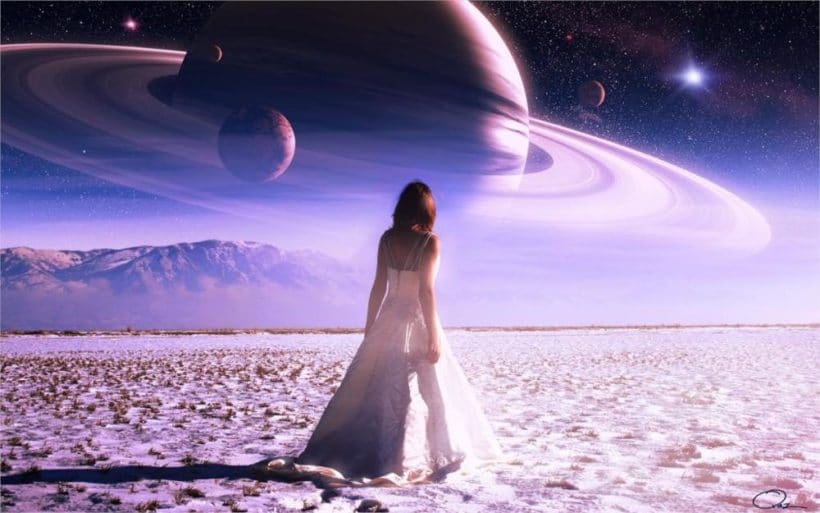
by Somya Devi | Sep 18, 2017 | Astrology, Conjunctions, Holy Days, Planets Changing Signs
New Moon in Virgo
The new lunar cycle begins Tuesday, September 19th, at 10:30 pm PDT, with Sun and Moon in sidereal Virgo. After a couple of months full of a lot of emotion and fire with many planets (and eclipses!) in Cancer and Leo, we have a chance to ground out a little bit more under the influence of earth-sign Virgo. Virgo is ruled by Mercury, the planet of the intellect, which brings a more practical and impartial nature to our energies this month. There is opportunity for curiosity and learning. The cycle begins in the Vedic nakshatra called Uttara Phalguni, which reminds us to take time in relaxation in order to re-kindle our productive energy.
The placement of Mercury and the nodes at the time of the Dark Moon, however, continue to make for a strong amount of “shadow” and subconscious energy to be present. Mercury, the lord of Virgo, will be in the 12th house from the Sun and Moon, and joining closely with Mars, showing a lot of intensity in the subconscious and potential for feeling disconnected. This New Moon also occurs under a full kala sarpa yoga, an alignment in which all seven planets are in between the two nodes of the Moon, Rahu and Ketu, in the cosmic circle.

Kala Sarpa
The kala sarpa yoga can be translated as “black snake” or “serpent of time.” The Moon transits the entire zodiac each month, so for two weeks of each month Moon will be on the other side of this axis, breaking the kala sarpa yoga, but for half of the month all planets will fall on one side of the “black serpent.” This will occur frequently over the next several months, when all seven planets will be situated to one side of the nodal axis (see photo) for half the month. The Moon transits the entire zodiac each month, so for two weeks of each month Moon will be on the other side of this axis, breaking the kala sarpa yoga, but for half of the month all planets will fall on one side of the “black serpent.”
When this alignment occurs, more of the shadowy and subconscious energy represented by the nodes is present. We may expect to be more introverted during this time, but it is also possible that more disruptive events can occur. People who are born under this alignment tend to have many “heavy” experiences throughout life. There can still be many positive and auspicious events during this time as well (or for those born under a kala sarpa yoga), but they tend to come after or despite some hardships or challenges.
Look for this yoga to occur for half the month from now through January of 2018. We experienced a similar occurrence last year (2016) from roughly September through January. This doesn’t happen every year, but we happen to be in a time where both Jupiter and Saturn, the slower-moving planets, are both to one side of the nodal axis. Thus this alignment occurs when the faster-moving planets, Sun, Mars, Mercury, and Venus, (plus Moon for half of each month) are also on one side of the axis.
Navaratri
Thankfully, there is a wonderful opportunity at hand to get in touch with the shadowy, subconscious energy of the nodes, through ritual worship and practice offered by Navaratri, the “nine-night” festival of the Goddess, which begins on the first day of this lunar cycle. This is a Hindu festival dedicated to worshiping the Goddess, Devi, in her many forms, for nine days and nights. As the night represents darkness and ignorance, we pray to her to help reveal and remove our shortcomings, bestow blessings, and confer wealth and knowledge. We face the darkness and call on the Divine Mother to remove it and let the atman, or the pure divinity within each of us, shine forth.
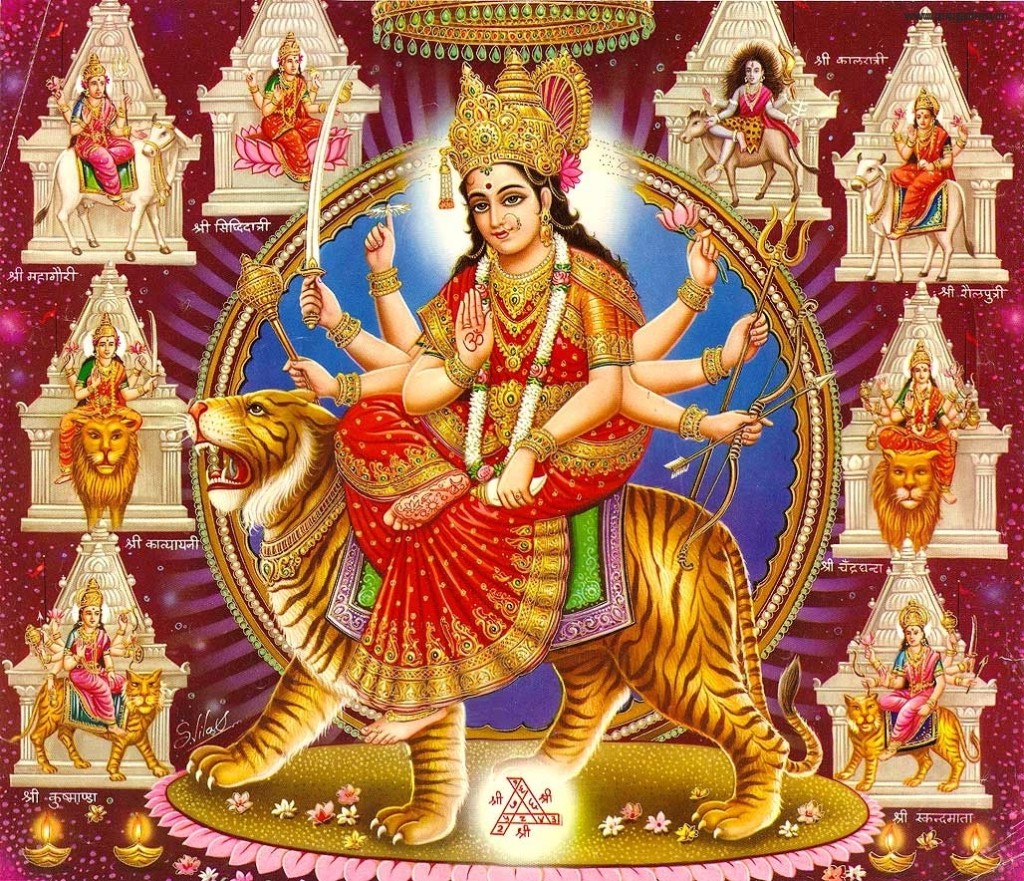 Navaratri worship can include creating a special altar to the Goddess, and making daily offerings including flowers, food, incense, light (a flame), ghee, as well as prayer, meditation, mantras and bhajans (devotional songs). The Devi Mahatmya (a.k.a. Chandi Path), the story of Durga, is a traditional text to read throughout this festival. Occurring in the fall-time in India and the northern hemisphere, this Navaratri also coincides with the harvest season, and is a time to give thanks for the abundance of the harvest and pray that it carries us through the winter season.
Navaratri worship can include creating a special altar to the Goddess, and making daily offerings including flowers, food, incense, light (a flame), ghee, as well as prayer, meditation, mantras and bhajans (devotional songs). The Devi Mahatmya (a.k.a. Chandi Path), the story of Durga, is a traditional text to read throughout this festival. Occurring in the fall-time in India and the northern hemisphere, this Navaratri also coincides with the harvest season, and is a time to give thanks for the abundance of the harvest and pray that it carries us through the winter season.
In many places, the first three nights of Navaratri are dedicated to Goddess in the form of Durga or Kali, warrior goddesses who help us to cleanse our impurities, the next three to Lakshmi, goddess of prosperity and devotion, and the last three to Sarasvati, goddess of wisdom. In other traditions, there are nine different forms of the Goddess honored on each of the nine days and nights. Be sure to follow me to receive daily updates throughout the festival!
Nodes Have Changed Signs
Since the onset of the eclipse cycle in early September, the nodes, Rahu and Ketu, have fully transitioned from the Leo-Aquarius axis to the Cancer-Capricorn axis. This completes one year-and-a-half transit as it begins another. From now through March of 2019, we will experience Rahu in Cancer and Ketu in Capricorn. The obsessive, insatiable Rahu in Cancer will cause us to experience a heightened state of emotionality throughout this time, with perhaps overwhelming sensitivity at times. The confusion of the nodes impels us to take time to get a better understanding of our hearts, and much will be revealed around the eclipse cycles that come in January-February 2018, July-August 2018, and January-February 2019.
With Ketu now transiting sidereal Capricorn, we will have to observe our shadows in the way that we balance our emotional nature with our practicality. Ketu in Capricorn could make us resistant to taking responsibility and practical steps for the future, but he will eventually raise self-awareness around any challenges we have here. We can be very self-critical in the area of Ketu’s transit, which will also affect each individual where Capricorn falls in the natal chart. Conversely, we may encounter impatience, restlessness, and even lust in the area of life indicated by Cancer in our natal chart, while Rahu transits there. I am happy to offer this Full Report and Forecast for Your Sign Here. (If you’re already on the free mailing list, you’ll be getting it in your inbox later today!)
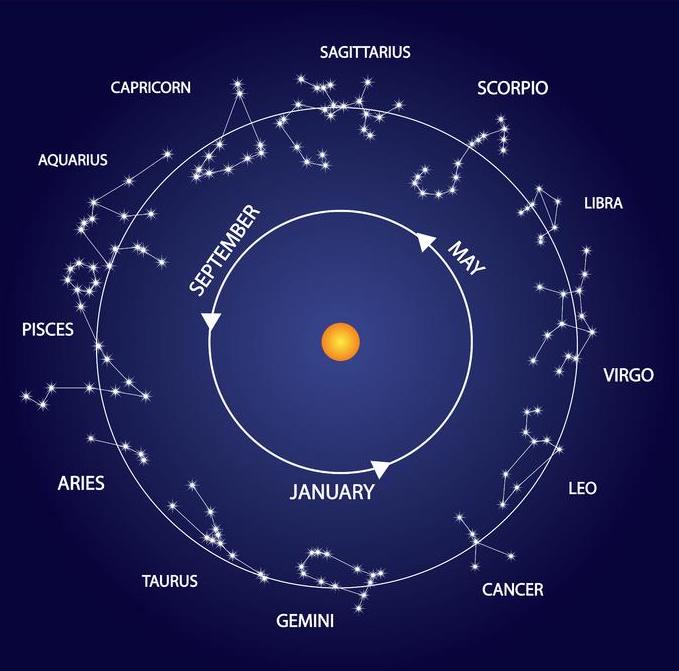
Jupiter in Virgo/Libra
Jupiter has technically transitioned zodiac signs recently, moving from sidereal Virgo’s into sidereal Libra’s designated slice of the pie-in-the-sky. Virgo is a much larger constellation than Libra, however, and in areas where abundant stars are visible just after sunset, one can see that Jupiter is still traversing the constellation of Virgo. The two do not each take up 30° of the 360° ring of the zodiac, in real observational terms, but rather Virgo takes up more than that portion while Libra covers less. Thus, we may be beginning to feel some energy of Jupiter in Libra (more inspiration for harmony, compromise, and the arts), I believe we are still experiencing a strong quality of Jupiter in Virgo (elevating our desire for organization of life’s details).
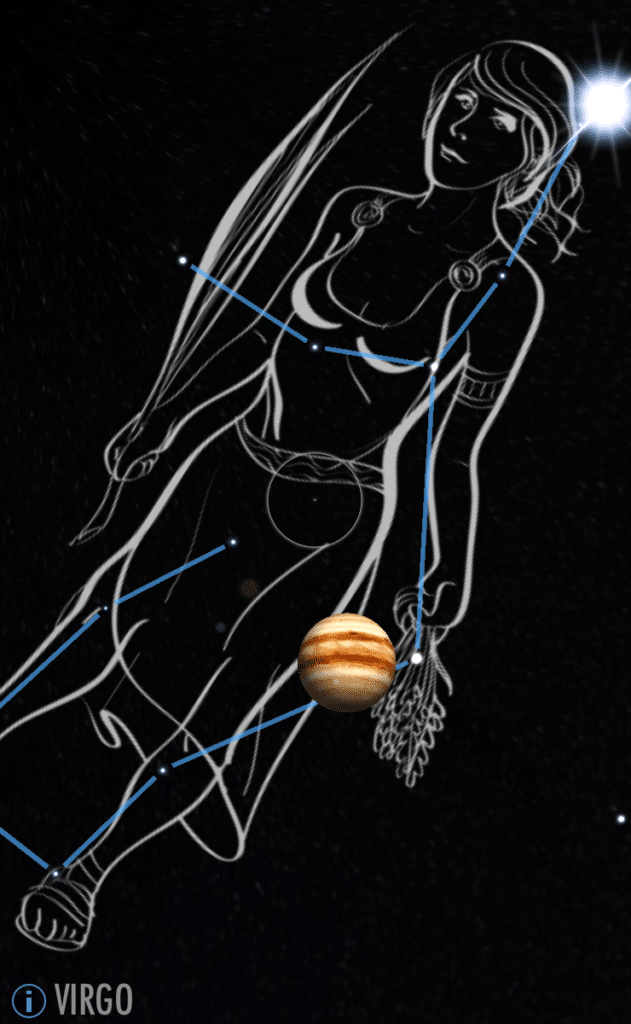 Also remember, most Western astrologers will say that Jupiter has been in Libra for the last year already, which can cause some confusion. That is based on the tropical zodiac, based on the seasons. Now is a great example of how the tropical zodiac does not correlate with the observable position of the planets and constellations as we see them from earth.
Also remember, most Western astrologers will say that Jupiter has been in Libra for the last year already, which can cause some confusion. That is based on the tropical zodiac, based on the seasons. Now is a great example of how the tropical zodiac does not correlate with the observable position of the planets and constellations as we see them from earth.
In the Vedic zodiac, Jupiter is still considered to be in the constellation of Chitra, which bridges the designations of Virgo and Libra. This nakshatra correlates with the star called Spica within Virgo (which Jupiter is closely conjunct at the moment), and translates as “the brilliant,” as it is one of the brightest stars in the sky. It is the sign of the celestial architect, and does bring forth a strong artistic quality. This is, therefore, a good time to allow your artistic inspiration to shine through, especially through both skillful and intelligent endeavors.
Mercury, Mars and Venus in Leo
Mercury, Mars, and Venus are all transiting sidereal Leo now. Venus in Leo can cause us to bring forth a lot of “me-first” in relationships, while the proximity of Mars and Mercury in this fire sign can lead to arguing, so be especially aware of these tendencies this month. The three are all catching an aspect from Saturn, now moving forward in direct motion in Scorpio, so that could help to add some mature caution to our impulses.
Save
Save
Save
Save
Save
Save
Save
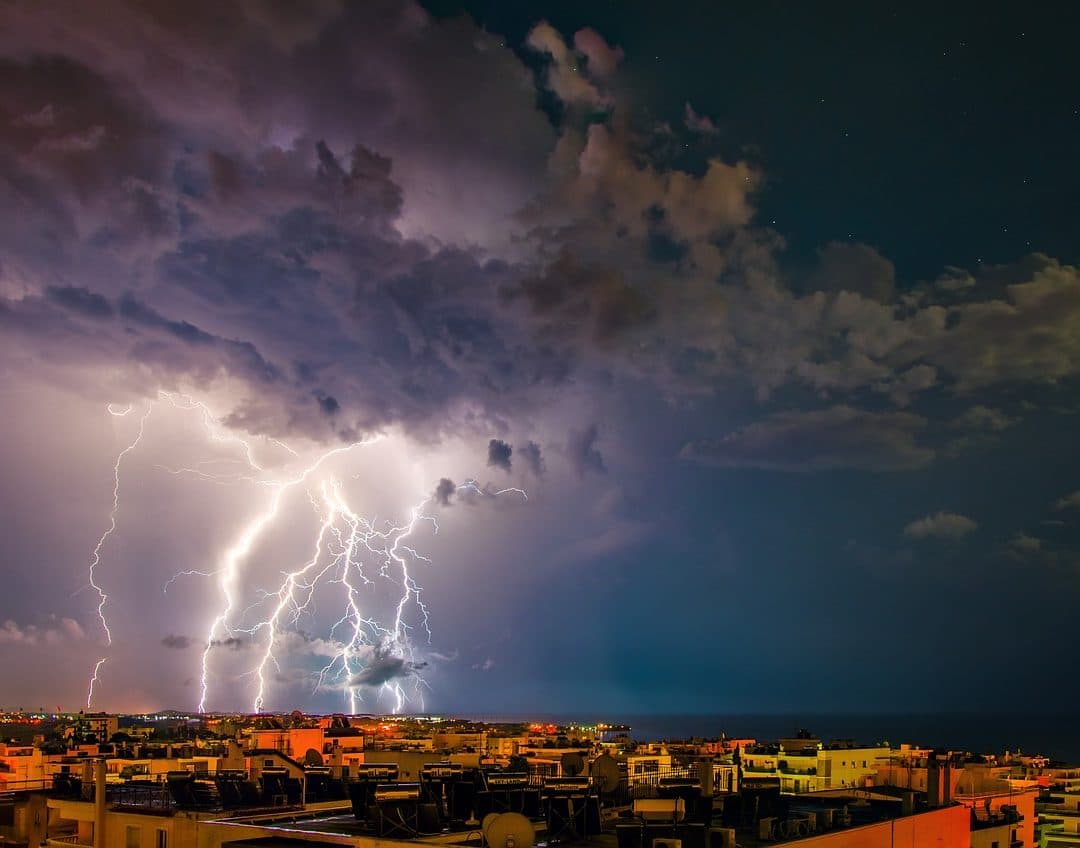
by Somya Devi | Jun 23, 2017 | Astrology, Conjunctions, Planets Changing Signs, Retrograde
The new lunar cycle begins tonight at 7:31 pm PDT. This dark Moon night finds four planets in the Vedic nakshatra called Ardra, located within the Gemini section of the sky. This nakshatra is actually located at the star Betelguese (also known as Alpha Orionis), a red supergiant star within the constellation of Orion. The Sun and Moon converge here tonight at 8° of sidereal Gemini, with Mercury close by at 11° and Mars at 18°. Aligned with the outermost edges of our galaxy, there is a powerful yet stormy energy to this nakshatra, and the month ahead may bring some intense changes, followed by a sense of renewal.
Rudra is the deity for this nakshatra, and he is a fierce form of Lord Shiva associated with storms and destruction. In Vedic thought, however, we recognize that the destructive aspect of creation is actually what allows change, transformation, and rebirth (sometimes I think of it as the cosmic composting process). Ardra nakshatra is often represented by a teardrop, which symbolizes the letting go that comes before new chapters begin. It is associated with the spring rains as well, which denotes the energy of renewal. After an intense storm the grounds are always moist and rich, and it is then that they are most fertile for new life to begin.
Nevertheless, when planets are in this part of the sky we often see rather intense and disruptive events worldwide. Since this alignment occurs on a new Moon, the energy is more inwardly directed, however, which could imply more inner work and processing, rather than outward turmoil … but some purification through disruptive cleansing or turbulence is still a possibility.
As this nakshatra aligns with the middle of Gemini, there is also a strongly intellectual and research-oriented quality to this new Moon, and the coming month. Gemini is the most flexible and quick-thinking of all the signs, as a mutable air-sign ruled by Mercury. Mercury is currently in his own sign, which opens up our curiosity, intellect, and analytical nature. Since he is so close to the Sun, however, he is combust at the moment, which can add a bit too much heat to our minds, and may cause our communication efforts to fail before completion. Mars is also nearby, adding even more heat (and aggression) to Mercury, so be careful not to allow your speech to become too intense, angry, or argumentative.
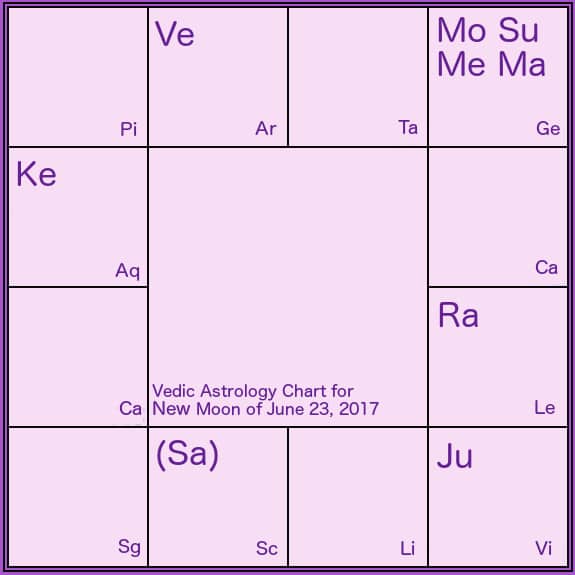 We can channel the power of this alignment by calling in discipline (from Mars), purification (from the Sun), and a heart-alignment (from the Moon), as we pursue research, communication, and learning this month. Travel is also a strong possibility, given so much mobile energy behind the planets. Gemini also gives us a strong ability to see both sides of a situation or argument. Represented by a pair of twins (or partners), Gemini represents both sides of a mirror at once, and really allows us to be more impartial and step into another’s shoes while reasoning. As of yesterday, Saturn is no longer aspecting Gemini, which frees us up from the pressure that he was putting on all the planets here for the last few weeks. He is still in a tight spot known as gandanta, however, and stronger feelings of constriction may persist for a few more weeks.
We can channel the power of this alignment by calling in discipline (from Mars), purification (from the Sun), and a heart-alignment (from the Moon), as we pursue research, communication, and learning this month. Travel is also a strong possibility, given so much mobile energy behind the planets. Gemini also gives us a strong ability to see both sides of a situation or argument. Represented by a pair of twins (or partners), Gemini represents both sides of a mirror at once, and really allows us to be more impartial and step into another’s shoes while reasoning. As of yesterday, Saturn is no longer aspecting Gemini, which frees us up from the pressure that he was putting on all the planets here for the last few weeks. He is still in a tight spot known as gandanta, however, and stronger feelings of constriction may persist for a few more weeks.
Saturn is now in Scorpio, and will continue there through late October. He is still in retrograde motion until the end of August, during which time we are feeling more introspective about our work and commitments. This is the last stretch of a roughly three-year transit of Saturn through Scorpio, which has brought some deep evaluation of our commitment to facing our fears and vulnerabilities, and putting in the hard work necessary for our personal path to transformation. There was also a lot of pressure and consideration of goals in the area of life indicated by Scorpio in each individual’s natal chart, and we the next for months are a time to re-affirm our insights and commitments here.*
The full Moon coming on July 8th is the one known as Guru Purnima, an auspicious day for giving thanks for all our teachers and gurus. This is a great time to acknowledge all those who have served your learning and evolution, including spiritual, theoretical, and vocational teachers. It is also a great chance to call forth the teacher within yourself, and recognize your potential to share what you have learned with others to whom your knowledge or experience may be of service. Guru is the name for Jupiter in Sanskrit, so it is also an auspicious time to connect with this planet.
*If you are already on my mailing list, you should have received the Saturn Retrograde Guide with Saturn-in-Scorpio forecast for your sign, either in April 2016 or when you joined the list, whichever is more recent. (Search your inbox for it if you’re already on the list!) If you’ve not yet joined the list, you can get the Saturn Retrograde Guide by signing up here, for free!
Save
Save
Save
Save
Save

by Somya Devi | Sep 26, 2016 | Astrology, Events, Holy Days
Maha Navaratri 2016 will be from October 1st-10th, the first ten days of this new lunar cycle. In this important Hindu holiday, we celebrate the Goddess through “the great nine nights.” Goddess, Devi, Shakti, Durga, Divine Mother, the many names and forms all represent the dynamic and fluid feminine power that enlivens all of existence.
She is the creatrix, the warrioress, the nurturer, the purifyer, the protector. While she’s in the innocent and fertile maiden so is she the wise and learned crone. Both the nurturing mother, and the one who gives “tough love.” The impassioned lover, the devoted bhakta, the disciplined yogini. We see Goddess appear through us in innumerable manifestations. Through her many forms she teaches us and offers us countless blessings–love, compassion, courage, learning, discipline, surrender, success, enlightenment, and bliss. This festival is a time for celebrating the supreme feminine power in all her glory, and the many blessings she bestows upon us.
As with most Hindu celebrations, this festival correlates with the lunar calendar, and thus begins on the first day of the waxing Moon after the New Moon of September 30th. The celebration is through the “nine nights” of October 1-9, 2016, and into the tenth morning known as Vijayadashami, “the day of victory,” on October 10th. Worship during Navaratri is most generally dedicated to Goddess in the form of Durga, the demon-slayer, but there is much nuance and variation to practice and forms of celebration throughout India. Above all, Navaratri is a community celebration of the Divine Mother, and the love, abundance and protection she gives.
There are many Navaratri celebrations throughout the year, but the fall-time Navaratri is the most widely celebrated, and is thus called Maha Navaratri – “the great nine nights”. It correlates with the time of the harvest, a time to give thanks for the abundance of the year’s work. Grains and crops are often offered to Devi as part of the celebrations. Ritualistic worship (puja) typically occurs in homes and temples throughout the nine nights and into the tenth morning of celebration.
The Many Forms of Goddess
Durga-Lakshmi-Sarasvati
In Kerala and other places in India, the first three nights of worship are dedicated to Durga (the invincible), the next three to Lakshmi (Goddess of prosperity), and the final three to Sarasvati (Goddess of learning). Durga helps us to destroy and remove the negative tendencies in our minds and hearts, freeing us from the obstructions to our spiritual and material pursuits. Lakshmi helps us to cultivate positive qualities like compassion and devotion, and leads us towards both spiritual and material prosperity. Sarasvati assists us in attaining knowledge and wisdom, through the illumination of our consciousness. She aids in awakening sattva, the quality of purity, and the flow of prana, the vital breath. After removing inner and outer obstacles and cultivating prosperity through virtuous qualities, our devotion, service, and practice help us to attain a state of peace, bliss, and oneness.
Sarasvati-Lakshmi-Kali/Durga
In the Kali Kula (Kali school of worship) in northeastern India, Sarasvati is worshiped on the first three nights, followed by Lakshmi and then Kali/Durga on the last three. Sarasvati, Lakshmi, and Kali/Durga (Kali emerged from Durga) are also known as the consorts of Brahma, Vishnu, and Shiva. The Goddesses, therefore, provide the shakti to the cosmic processes of creation, preservation, and death/transformation, similar to their male counterparts. Consequently, worship in this manner is dedicated to the cycles of life and Mother nature, through birth, then sustenance, then death. Death is not a complete stop, but allows for the regeneration of energy into a new cycle once again.
9 Forms of Goddess
Throughout India, the nine nights of Navaratri are often dedicated to 9 different incarnations of Durga, allowing the worship of many different aspects of Shakti in a gradual evolution. You can read the stories and significance of these 9 goddesses here, or a more a brief introduction, here:
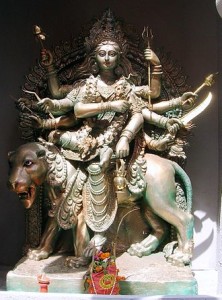 1. Shailputri
1. Shailputri
“Daughter of the mountain”; creative energy, muladhara (root chakra), awakening; Awaken your connection with Goddess today or initiate a new venture, calling on Shailputri for new beginnings.
2. Brahmacharini
The ascetic; tapas, discipline, devotion, strength, wisdom, creative abundance; Good day for fasting and meditation, connection with svadhistana (sacral chakra).
3. Chandraghanta
Warrioress; protection, courage, grace, manipura (solar plexus); Destroy your internal obstacles by offering them to Chandraghanta.
4. Kushmanda
Creatrix of the “cosmic egg”; strength, health, happiness, success, relationships; Connect with the vital Sun energy and the anahata (heart chakra) today.
5. Skandamata
“Mother of Skanda/Kartikeya”; motherly love, nourishment, protection, purity; Call on divine truth through the vishuddha (throat chakra), invoking Skandamata to lead you towards victory.
6. Katyayani
Warrioress who destroyed Mahishasura (the buffalo demon); victory, devotion, strength, removing obstacles; Meditate on these qualities of Goddess through the ajna chakra (third-eye) today.
7. Kalaratri
“Dark/black night,” representing a fierce form of Durga/Kali; darkness, death, surrender, dissolution of pain; Connecting with the sahasrara (crown chakra), remember that Divine Mother offers love, compassion, and many blessings even in hard times. Even in the midst of apparent darkness, and helps us to go beyond the boundaries of the material body-mind and connect with spirit.
8. Mahagauri
“Great white goddess”; detachment, purification, renewal, protection, virtue; Through detachment and devotion, we emerge purified, shining and radiant after surrendering in the dark night. Rejuvenative herbs and foods are good today.
9. Siddhidatri
Goddess of “siddhis”; magical, spiritual or mystic powers and blessings, fulfillment of desires, devotion, divine union; Invite Goddess to reveal her presence to you everywhere and in every moment.
Personal Practice Ideas for Navaratri
If possible, it is great to reduce our workload and gather with community at local temples or places of worship. We can also create a little time and space at home and conduct some personal practices to celebrate Goddess energy. Here are some ideas to do at home or with a group throughout the nine nights of Navaratri:
Altar
Create a sacred space, a Durga altar, or a Goddess altar. Even if you already have one, you can refresh it in some way or rearrange it specifically for Navaratri. Include images or statues of the Goddess(es) you have a relationship with. This could be according to one of the groups of forms above.
Invocation
Even if you don’t have much time, dedicate at least a few minutes each day to connecting with the Divine Mother in front of your altar.
Journal
Write in your journal about what qualities of Goddess you perceive and connect with. What aspects would you like to strengthen or to cultivate more deeply? Write any and all prayers and offer them to the form of Goddess that appeals to you.
Light
Offer light to illuminate Goddess’s power, helping her to shine more brightly into the world and your life. You can light a candle by the altar and keep it burning when you’re at home. You can even keep an electronic tealight on symbolically when you are away.
Flowers/Grains
Offer flowers or grains (even a small dish of dried rice) to celebrate Devi in the form of mother nature, fertility, the abundance of the harvest, and the cycle of life.
Offerings
Offer incense, bells, water, or food if you feel called, by placing it on the altar, or mentally offering it to Goddess throughout the day. You can also offer something symbolic of your own work or practice, whatever you have been cultivating for harvest through the year. In offering this you surrender the fruits of your efforts to the Divine Mother.
Fasting
Some people choose to fast in some variation, if this is something you have practiced before. This might include fasting during the day, fasting with only milk or fruit, or abstaining from alcohol and non-vegetarian foods during Navaratri.
Chanting
Chanting the Devi Mahatmyam, a verse to the Goddess, is a common practice during the nine-night festival. You can also chant another Goddess mantra or songs that are special to you and your relationship with Devi.
JAI MA DURGA!
Personal Vedic Astrology chart readings and forecasts are available Here.
Did you like Maha Navaratri 2016? Please Like, Comment and Share!
Save
Save
Save

 Navaratri
Navaratri







 Navaratri worship can include creating a special altar to the Goddess, and making daily offerings including flowers, food, incense, light (a flame), ghee, as well as prayer, meditation, mantras and bhajans (devotional songs). The Devi Mahatmya (a.k.a. Chandi Path), the story of Durga, is a traditional text to read throughout this festival. Occurring in the fall-time in India and the northern hemisphere, this Navaratri also coincides with the harvest season, and is a time to give thanks for the abundance of the harvest and pray that it carries us through the winter season.
Navaratri worship can include creating a special altar to the Goddess, and making daily offerings including flowers, food, incense, light (a flame), ghee, as well as prayer, meditation, mantras and bhajans (devotional songs). The Devi Mahatmya (a.k.a. Chandi Path), the story of Durga, is a traditional text to read throughout this festival. Occurring in the fall-time in India and the northern hemisphere, this Navaratri also coincides with the harvest season, and is a time to give thanks for the abundance of the harvest and pray that it carries us through the winter season.
 Also remember, most Western astrologers will say that Jupiter has been in Libra for the last year already, which can cause some confusion. That is based on the tropical zodiac, based on the seasons. Now is a great example of how the tropical zodiac does not correlate with the observable position of the planets and constellations as we see them from earth.
Also remember, most Western astrologers will say that Jupiter has been in Libra for the last year already, which can cause some confusion. That is based on the tropical zodiac, based on the seasons. Now is a great example of how the tropical zodiac does not correlate with the observable position of the planets and constellations as we see them from earth.
 We can channel the power of this alignment by calling in discipline (from Mars), purification (from the Sun), and a heart-alignment (from the Moon), as we pursue research, communication, and learning this month. Travel is also a strong possibility, given so much mobile energy behind the planets. Gemini also gives us a strong ability to see both sides of a situation or argument. Represented by a pair of twins (or partners), Gemini represents both sides of a mirror at once, and really allows us to be more impartial and step into another’s shoes while reasoning. As of yesterday, Saturn is no longer aspecting Gemini, which frees us up from the pressure that he was putting on all the planets here for the last few weeks. He is still in a tight spot known as gandanta, however, and stronger feelings of constriction may persist for a few more weeks.
We can channel the power of this alignment by calling in discipline (from Mars), purification (from the Sun), and a heart-alignment (from the Moon), as we pursue research, communication, and learning this month. Travel is also a strong possibility, given so much mobile energy behind the planets. Gemini also gives us a strong ability to see both sides of a situation or argument. Represented by a pair of twins (or partners), Gemini represents both sides of a mirror at once, and really allows us to be more impartial and step into another’s shoes while reasoning. As of yesterday, Saturn is no longer aspecting Gemini, which frees us up from the pressure that he was putting on all the planets here for the last few weeks. He is still in a tight spot known as gandanta, however, and stronger feelings of constriction may persist for a few more weeks.